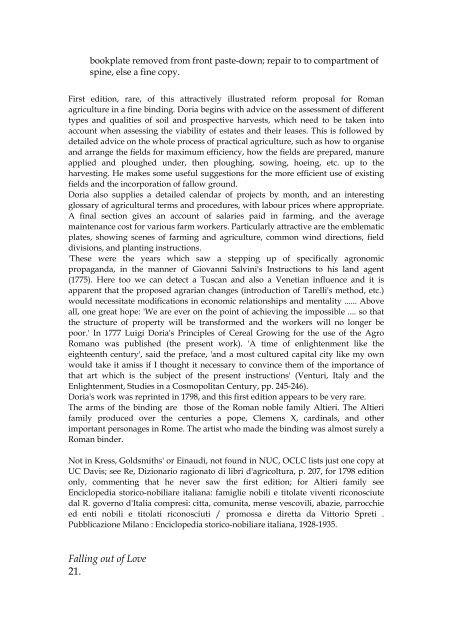«Merge Record #»«Title» - Schulz-Falster Rare Books
«Merge Record #»«Title» - Schulz-Falster Rare Books
«Merge Record #»«Title» - Schulz-Falster Rare Books
Create successful ePaper yourself
Turn your PDF publications into a flip-book with our unique Google optimized e-Paper software.
ookplate removed from front paste-down; repair to to compartment of<br />
spine, else a fine copy.<br />
First edition, rare, of this attractively illustrated reform proposal for Roman<br />
agriculture in a fine binding. Doria begins with advice on the assessment of different<br />
types and qualities of soil and prospective harvests, which need to be taken into<br />
account when assessing the viability of estates and their leases. This is followed by<br />
detailed advice on the whole process of practical agriculture, such as how to organise<br />
and arrange the fields for maximum efficiency, how the fields are prepared, manure<br />
applied and ploughed under, then ploughing, sowing, hoeing, etc. up to the<br />
harvesting. He makes some useful suggestions for the more efficient use of existing<br />
fields and the incorporation of fallow ground.<br />
Doria also supplies a detailed calendar of projects by month, and an interesting<br />
glossary of agricultural terms and procedures, with labour prices where appropriate.<br />
A final section gives an account of salaries paid in farming, and the average<br />
maintenance cost for various farm workers. Particularly attractive are the emblematic<br />
plates, showing scenes of farming and agriculture, common wind directions, field<br />
divisions, and planting instructions.<br />
'These were the years which saw a stepping up of specifically agronomic<br />
propaganda, in the manner of Giovanni Salvini's Instructions to his land agent<br />
(1775). Here too we can detect a Tuscan and also a Venetian influence and it is<br />
apparent that the proposed agrarian changes (introduction of Tarelli's method, etc.)<br />
would necessitate modifications in economic relationships and mentality ...... Above<br />
all, one great hope: 'We are ever on the point of achieving the impossible .... so that<br />
the structure of property will be transformed and the workers will no longer be<br />
poor.' In 1777 Luigi Doria's Principles of Cereal Growing for the use of the Agro<br />
Romano was published (the present work). 'A time of enlightenment like the<br />
eighteenth century', said the preface, 'and a most cultured capital city like my own<br />
would take it amiss if I thought it necessary to convince them of the importance of<br />
that art which is the subject of the present instructions' (Venturi, Italy and the<br />
Enlightenment, Studies in a Cosmopolitan Century, pp. 245-246).<br />
Doria's work was reprinted in 1798, and this first edition appears to be very rare.<br />
The arms of the binding are those of the Roman noble family Altieri. The Altieri<br />
family produced over the centuries a pope, Clemens X, cardinals, and other<br />
important personages in Rome. The artist who made the binding was almost surely a<br />
Roman binder.<br />
Not in Kress, Goldsmiths' or Einaudi, not found in NUC, OCLC lists just one copy at<br />
UC Davis; see Re, Dizionario ragionato di libri d'agricoltura, p. 207, for 1798 edition<br />
only, commenting that he never saw the first edition; for Altieri family see<br />
Enciclopedia storico-nobiliare italiana: famiglie nobili e titolate viventi riconosciute<br />
dal R. governo d'Italia compresi: citta, comunita, mense vescovili, abazie, parrocchie<br />
ed enti nobili e titolati riconosciuti / promossa e diretta da Vittorio Spreti .<br />
Pubblicazione Milano : Enciclopedia storico-nobiliare italiana, 1928-1935.<br />
Falling out of Love<br />
21.
















